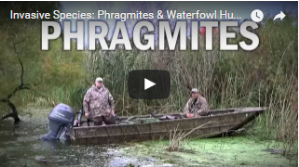|
Oct. 10, 2016
Contact: Kevin Walters, 517-284-5473 or Joanne Foreman, 517-284-5814
Waterfowl hunters can help stop spread of invasive phragmites
Invasive phragmites is spreading across Michigan. Tall stands of reed-like grass reaching heights of 15 feet are cropping up along roadways and in wetlands, lakes, rivers and ponds. While conservation organizations and landowners are hard at work battling this habitat menace, Michigan’s Invasive Species Program is calling on hunters to do their part to stop the spread of invasive phragmites. This is particularly important now that waterfowl season is open in many parts of the state (Check the DNR’s waterfowl hunting seasons for your local area).
How does it happen?
New invasions can start from windblown seeds or from fragments of the plant’s roots - known as rhizomes. If you hunt in areas where invasive phragmites is growing, these seeds and fragments can stick to gear, including decoys,  anchors, waders, and even dogs. Using invasive phragmites to camouflage boats or blinds can also spread the problem. Instead, hunters are encouraged to use synthetic materials or native plants such as cedar boughs for camouflage. anchors, waders, and even dogs. Using invasive phragmites to camouflage boats or blinds can also spread the problem. Instead, hunters are encouraged to use synthetic materials or native plants such as cedar boughs for camouflage.
Want to know more? Take a few minutes to watch this new video that quickly explains how hunters can help stop the spread of invasive phragmites.
Why does it matter?
Invasive phragmites can overtake waterfowl habitat, replacing native cover and food sources with tall, dense stands of reed-like grass. For hunters, this means poor visibility, difficult access to water and decreased game bird populations in infested areas.
Once invasive phragmites becomes established, it is difficult and costly to treat, and it may take years before native habitat can be restored.
What can you do?
- Know how to identify invasive phragmites – visit Michigan's invasive species website and learn more about what to watch for.
- Share this email and video link with fellow hunters, family and friends. If sharing on social media, please use the tag #NotMiSpecies.
- If you notice invasive phragmites or other invasive species in areas where you haven’t seen them before, report them from your smartphone using the downloadable MISIN app.
- Believe that you can make a difference, and remember these easy tips.
The Michigan Department of Natural Resources is committed to the conservation, protection, management, use and enjoyment of the state’s natural and cultural resources for current and future generations. For more information, go to www.michigan.gov/dnr.
|







